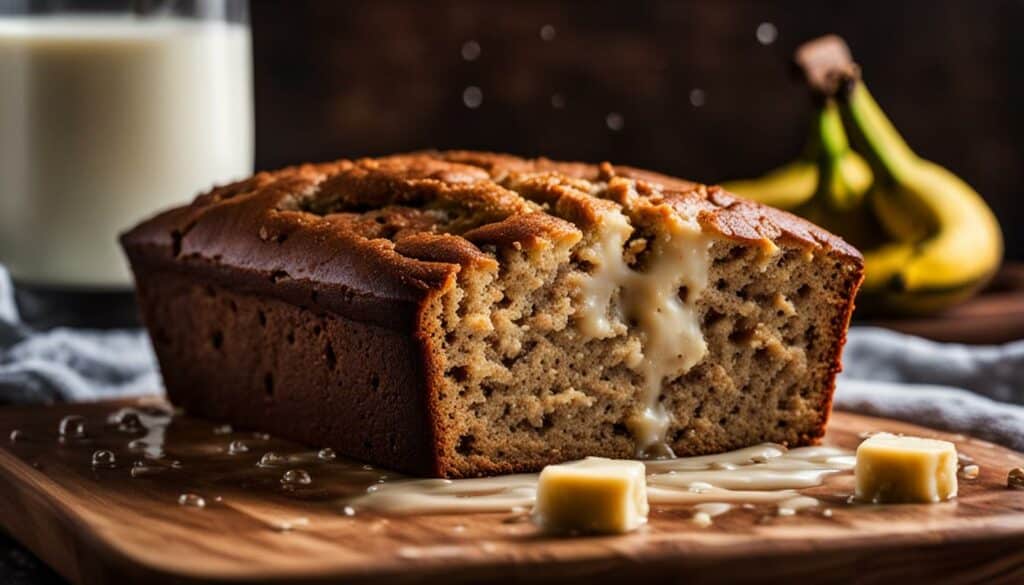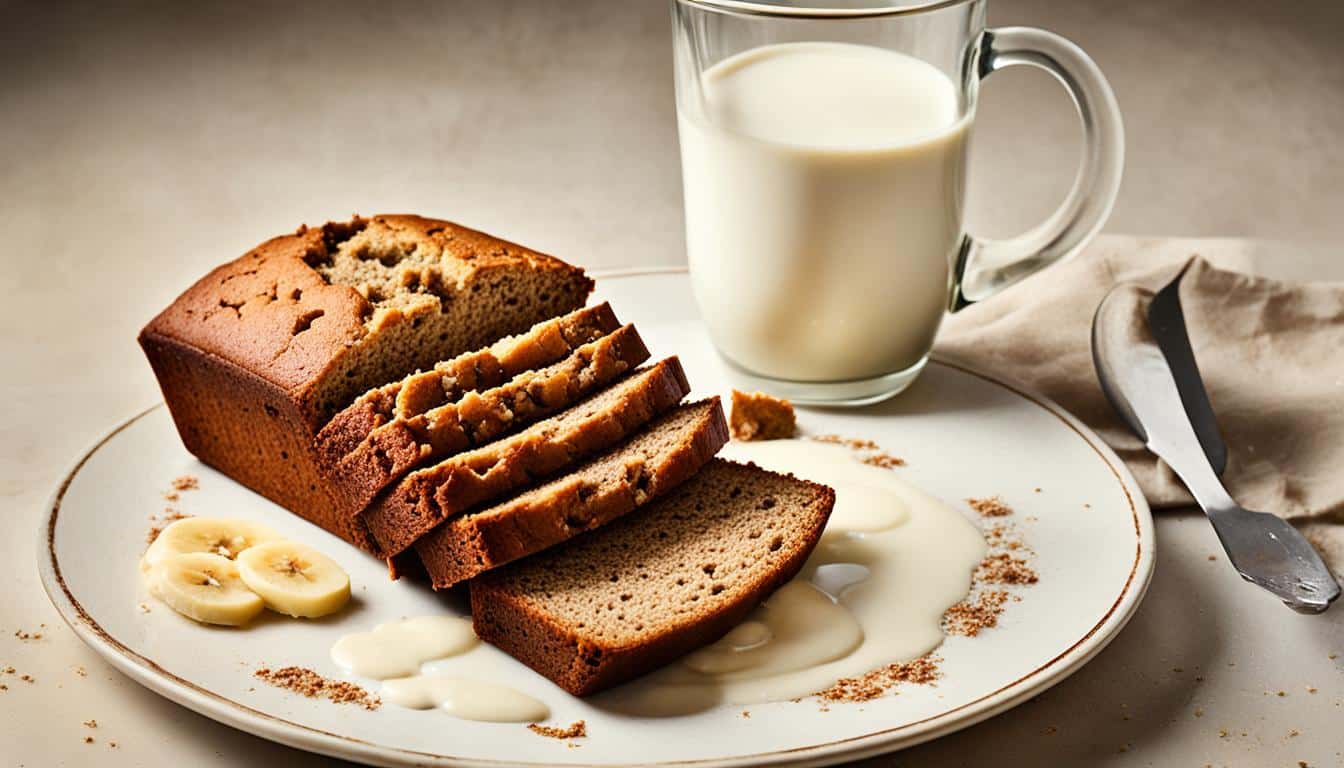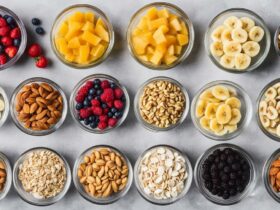When it comes to baking delicious banana bread, one ingredient that plays a significant role is milk. But what exactly does milk do to banana bread, and why is it so important to include it in your recipe? Let’s explore the benefits of using milk in banana bread and the science behind its impact on the final product.
Milk not only adds nutritional value to your banana bread but also enhances its texture and flavor. It provides essential nutrients like protein, calcium, and vitamin B12, making your bread a wholesome treat. The fat and lactose in milk work together to tenderize the crumb, resulting in a softer and more delicate texture. Additionally, milk contributes to the caramelization of the crust, giving it a rich and slightly sweet taste.
Whether you prefer cow’s milk, buffalo milk, or even almond milk, each type can be used in banana bread recipes, imparting its unique flavors and characteristics. Milk powder is also a convenient alternative, often used in bakeries for its longer shelf life. It offers similar nutritional benefits to fresh milk but needs to be mixed with the right amount of water to achieve the desired dough hydration.
By including milk in your banana bread recipe, you can elevate the overall taste and quality of the bread. It adds depth and richness to the flavor profile while ensuring a moist and tender texture. Milk truly is an indispensable ingredient when it comes to creating a delightful banana bread that everyone will love.
Key Takeaways:
- Milk adds nutritional value to banana bread, providing protein, calcium, and vitamin B12.
- The fat and lactose in milk tenderize the crumb, resulting in a softer texture.
- Milk contributes to the caramelization of the crust, enhancing the flavor.
- Different types of milk, such as cow’s milk, buffalo milk, and almond milk, can be used in banana bread recipes.
- Milk powder is a convenient alternative with a longer shelf life, but it needs to be mixed with water following the recommended ratio.
The Impact of Different Types of Milk on Banana Bread
When it comes to making banana bread, the type of milk you use can have a significant impact on the outcome. Cow’s milk, buffalo milk, and almond milk each bring their own unique flavors and characteristics to the recipe. Let’s explore the differences and discover how to choose the right milk for your banana bread.
The Creamy Richness of Cow’s Milk
Cow’s milk is the most commonly used milk in baking, including banana bread. It lends a rich and creamy flavor to the bread, enhancing its overall taste. The protein, calcium, and vitamin B12 found in cow’s milk also add nutritional value to the bread, making it a wholesome treat.
The Richness and Moisture of Buffalo Milk
Buffalo milk, with its higher fat content compared to cow’s milk, adds an extra level of richness and moisture to the banana bread. This type of milk is ideal for those who prefer a denser and more indulgent texture in their baked goods. The higher fat content contributes to a moist crumb and a luscious flavor.
A Nutty and Low-Sugar Alternative: Almond Milk
For those looking for a plant-based and lower-sugar option, almond milk is a fantastic choice. Almond milk adds a subtle nutty flavor to the banana bread, complementing the sweetness of the bananas. It is also lower in calories and sugar compared to cow’s milk, making it a healthier alternative without compromising taste.
Whether you choose cow’s milk, buffalo milk, or almond milk, selecting the right milk for your banana bread depends on your personal preferences and dietary requirements. Consider the flavors and characteristics of each type of milk to create the perfect banana bread tailored to your taste. Experimenting with different types of milk can lead to delightful variations in flavor and texture.
Now that we’ve explored the impact of different types of milk on banana bread, let’s further delve into the differences between milk powder and fresh milk in the next section.
| Type of Milk | Flavor | Texture | Nutritional Value |
|---|---|---|---|
| Cow’s Milk | Rich and creamy | Soft and tender | Protein, calcium, vitamin B12 |
| Buffalo Milk | Indulgent and flavorful | Dense and moist | Higher fat content |
| Almond Milk | Subtle nutty flavor | Light and moist | Low in calories and sugar |
Milk Powder vs. Fresh Milk in Banana Bread
When it comes to baking banana bread, the choice between using milk powder or fresh milk can be a topic of debate. Both options have their own advantages and considerations to keep in mind. Let’s explore the differences and benefits of using milk powder in banana bread.
The Convenience of Milk Powder in Baking
Milk powder is a convenient alternative to fresh milk, especially in bakeries or situations where fresh milk may not be readily available. One of the significant advantages of milk powder is its longer shelf life, which means it doesn’t spoil as quickly as fresh milk. This makes it a reliable option to keep on hand for baking purposes.
Adjusting Hydration with Milk Powder
When using milk powder in banana bread recipes, it is crucial to mix it with the appropriate amount of water to achieve the desired hydration of the dough. The recommended ratio of milk powder to water should be followed to ensure the proper consistency. By adjusting the hydration, you can achieve the ideal texture and moisture in your banana bread.
Benefits of Using Milk Powder in Banana Bread
Milk powder provides similar nutritional benefits to fresh milk when properly mixed. It contains essential nutrients like protein, calcium, and vitamins. However, it’s important to note that milk powder has a higher fat and sugar content compared to fresh milk. These percentages decrease when mixed with water, so adjusting the hydration helps balance these factors.
Differences Between Milk Powder and Fresh Milk in Banana Bread
There are a few notable differences between milk powder and fresh milk when used in banana bread recipes. Fresh milk brings a distinct flavor and creaminess to the bread, whereas milk powder may have a slightly different taste due to the manufacturing process. Additionally, fresh milk requires refrigeration and has a shorter shelf life, whereas milk powder offers convenience and a longer storage time.
In summary, milk powder is a convenient alternative to fresh milk in banana bread recipes. It provides similar nutritional benefits and can help achieve the desired texture and moisture in the bread. However, it’s important to note that using milk powder requires adjusting the hydration of the dough. Consider your priorities, convenience, and desired taste when deciding between milk powder and fresh milk for your next batch of delicious banana bread.
The Effect of Milk on Banana Bread Texture and Flavor
Milk plays a crucial role in enhancing the texture and flavor of banana bread. Its impact extends to both the tenderizing effect on the bread’s crumb and the caramelization of its crust.
The fat and lactose present in milk contribute to the tenderization of the banana bread’s crumb, resulting in a softer and more delicate texture. These components help create a moist and tender crumb that melts in your mouth with every bite.
Additionally, milk plays a significant role in caramelizing the crust of the banana bread. When baked, milk contributes to the formation of a golden brown and slightly sweet crust. This caramelization process enhances the overall flavor, adding depth and richness to the bread’s taste.
By incorporating milk into your banana bread recipe, along with other key ingredients like butter, eggs, and sugar, you can maximize the flavor profile and create a delightful sensory experience. The combination of these elements elevates the overall taste and appeal of the banana bread, making it a favorite treat for any occasion.

When baking banana bread, don’t underestimate the impact of milk. It not only contributes to the bread’s moisture and tenderness but also adds a distinct caramelized flavor to the crust. Experiment with different types of milk and embrace the variety of flavors they bring to your banana bread recipes.
The Importance of Milk in Banana Bread Recipes
Milk plays a vital role in creating delicious and satisfying banana bread. It not only adds nutritional value but also enhances the overall flavor and texture of the bread. Using milk in banana bread recipes provides several benefits that contribute to a mouthwatering final product.
The Role of Milk in Banana Bread
When it comes to the nutritional aspect, milk is a valuable ingredient. It delivers essential nutrients such as protein, calcium, and vitamin B12, making the bread a healthier choice for those following a balanced diet. These nutrients are critical for maintaining strong bones and supporting overall well-being.
But milk’s significance in banana bread goes beyond its nutritional value. The fat and lactose present in milk help in tenderizing the crumb, resulting in a soft and moist texture. This texture is what makes every bite of banana bread irresistible.
Maximizing Flavor with Milk
In addition to its role in texture, milk also contributes to the flavor of banana bread. The caramelization of the crust, brought about by incorporating milk into the recipe, adds a delightful depth and richness to the overall taste. You can expect a harmonious balance of sweetness and subtle creaminess that will leave your taste buds wanting more.
Whether you choose to use cow’s milk, buffalo milk, or even almond milk, each type brings its own unique flavor profile to the banana bread. The creamy richness of cow’s milk, the added moisture from buffalo milk, or the mellow nuttiness of almond milk can transform ordinary banana bread into a flavor-packed treat.
Using Milk for Nutritional Value
Milk is a key component for maximizing the nutritional value of banana bread. By incorporating it into the recipe, you ensure that the bread becomes a source of protein, calcium, and vitamin B12. These nutrients are essential for supporting a healthy lifestyle and are especially beneficial for those looking to add more nutrients to their diet.

“Milk adds nutritional value, enhances the texture, and contributes to the caramelization of the crust in banana bread.”
Overall, milk’s importance in banana bread recipes cannot be overstated. It provides nutritional benefits while enhancing the texture and flavor of the bread. So, the next time you bake a batch of banana bread, don’t forget to include milk for that extra touch of deliciousness.
Conclusion
In conclusion, milk plays a crucial role in the success of a delicious banana bread recipe. Its impact on the texture, moisture, and flavor of the bread is significant. By adding milk to the recipe, you not only enhance the overall taste but also introduce valuable nutritional value to your bread.
Whether you choose to use cow’s milk, buffalo milk, or almond milk, each type adds its own unique flavors and characteristics to the banana bread. This allows you to experiment and find the perfect combination that suits your taste preferences.
If you prefer the convenience of milk powder, it is important to remember to mix it with water according to the recommended ratio. This ensures that you achieve the desired hydration of the dough while still enjoying the benefits of milk in your banana bread.
When using milk in your recipes, it’s crucial to consider the fat, sugar, and water content to maintain the desired texture and flavor. Whether it’s making the crumb softer and more delicate or contributing to the caramelization of the crust, milk is a valuable ingredient that elevates the overall quality of your banana bread.
So, the next time you bake a batch of banana bread, don’t forget to include milk in your recipe. It’s the secret ingredient that will take your banana bread to the next level of deliciousness!
FAQ
What does milk do to banana bread?
Milk adds nutritional value to banana bread, such as protein, calcium, and vitamin B12. It also helps tenderize the crumb, making it softer and sweeter. Milk contributes to the caramelization of the crust, enhancing the flavor of the bread.
What are the benefits of using milk in banana bread?
Using milk in banana bread provides additional nutritional value and contributes to the texture and flavor of the bread. Milk adds protein, calcium, and vitamin B12 to the recipe. It helps tenderize the crumb, resulting in a softer and moister bread. Milk also enhances the caramelization of the crust, adding richness and sweetness.
How does milk affect banana bread?
Milk affects banana bread by tenderizing the crumb, making it softer and more delicate. It adds moisture to the bread and enhances its flavor. The fat and lactose in milk contribute to the caramelization of the crust, creating a rich and slightly sweet taste.
What is the importance of milk in a banana bread recipe?
Milk plays a crucial role in a banana bread recipe. It adds nutritional value, such as protein, calcium, and vitamin B12, to the bread. Milk also enhances the texture and flavor of the bread, making it softer and sweeter. It contributes to the caramelization of the crust, adding richness and depth to the overall taste.
Why should I use milk in banana bread?
Using milk in banana bread provides various benefits. It adds nutritional value, improves the texture, and enhances the flavor of the bread. Milk adds protein, calcium, and vitamin B12 to the recipe. It tenderizes the crumb, making it softer and moister. Milk also contributes to the caramelization of the crust, adding richness and sweetness.
How does different types of milk impact banana bread?
Different types of milk, such as cow’s milk, buffalo milk, and almond milk, have varying effects on banana bread. Cow’s milk provides a rich and creamy flavor, while buffalo milk adds richness and moisture. Almond milk is a lower-sugar option that maintains nutritional value. Each type of milk has unique flavors and characteristics that can be used to enhance banana bread recipes.
Can I use milk powder in banana bread recipes?
Yes, milk powder can be used in banana bread recipes. It is often used in bakeries as a convenient alternative to fresh milk. However, it is important to mix it with the appropriate amount of water to achieve the desired hydration of the dough. Milk powder has a higher fat and sugar content, which decreases when diluted in water.
What is the impact of milk powder on banana bread?
Milk powder provides similar nutritional benefits to fresh milk in banana bread. It has a longer shelf life and does not spoil as quickly. When using milk powder, it is crucial to follow the recommended ratio of powder to water to ensure the proper hydration of the dough. While milk powder can be a convenient alternative, it may be more expensive than using fresh milk.
How does milk affect the texture and flavor of banana bread?
Milk plays a crucial role in the texture and flavor of banana bread. It tenderizes the crumb, resulting in a softer and more delicate texture. The crust of the bread benefits from the caramelization caused by the addition of milk, giving it a rich and slightly sweet flavor. Overall, milk enhances the overall appeal of banana bread.
What is the role of milk in banana bread recipes?
Milk is an essential ingredient in banana bread recipes for several reasons. It adds nutritional value, including protein, calcium, and vitamin B12. Milk helps tenderize the crumb and contribute to a soft and moist texture. It also enhances the caramelization of the crust, adding depth and richness to the bread. Overall, milk plays a crucial role in creating a delicious and satisfying banana bread.







